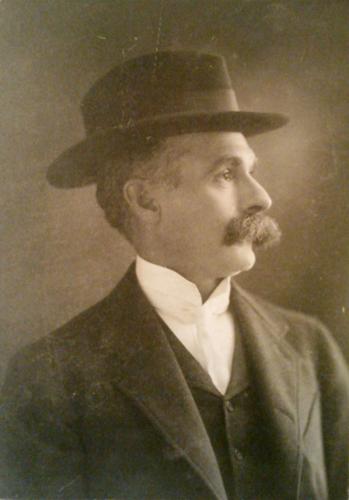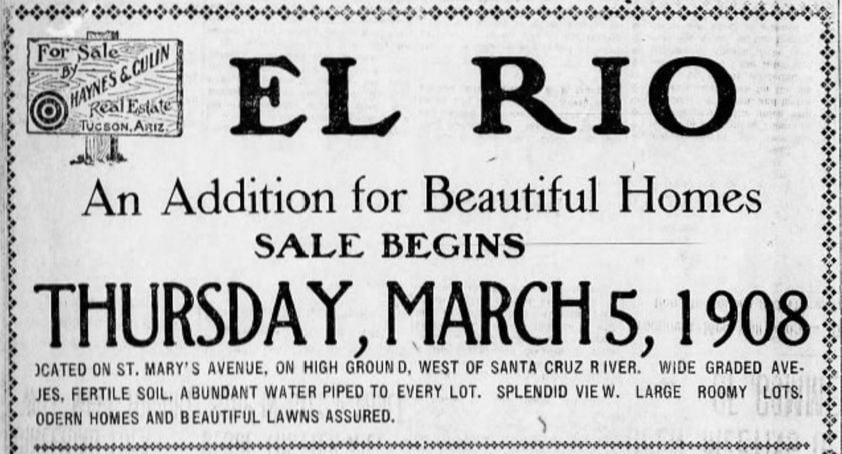Willis P. Haynes was a jack-of-all-trades whose claims to fame here included being hailed as an “ornament” of Tucson society, to taking the earliest photographs of UA’s Old Main, to establishing the bullseye logo long used by Tucson Realty & Trust.
He was born to John and Jane Haynes on Feb. 18, 1857 in Zanesville, Ohio, where his father was a prominent attorney. After his mother died in 1876, his father, now suffering from ill health, decided to move himself and his only son to San Francisco, Calif..
In 1879, his father traveled to Arizona to look at some mining interests but found what he really needed: a climate good for his health. He soon relocated to Tucson, where he helped found the legal firm of Haynes, Lucas & Street. The next year he wed Julia Heney.
In 1881, Haynes followed his father and stepmother to the Old Pueblo and worked in his father’s office, at 15 S. Meyer Street, as a notary public. The next year Haynes left for Concord, New Hampshire, with the Arizona Daily Star writing of the young man, “In him Tucson society loses one of its brightest ornaments. A gentleman of rare culture and of genial, courteous manner, he was a favorite with all who knew him.”
His time in New England was short-lived as, by late 1884, he was back in town working for W.W. Hayward, who collected news for sale for journals. The next year Haynes became an agent for J. Dewing & Co. of San Francisco, selling the two-volume set of the “Personal Memoirs of U.S. Grant.”
In 1886, Haynes, along with partners Henry Crepin Jr. and Paul F. Brown, took up 160 acres of land on the Rillito River, near the Wetmore family homestead, for a fruit ranch.
Also that year, Haynes began his career in photography by taking two lessons from the owner of a Waterbury photographic outfit. Soon after Haynes founded a photographic gallery and laboratory at 8 Stone Ave. and started advertising his services as a landscape photographer to towns, mining businesses and cattle companies. The years 1887 to 1890 saw him capturing still images of Tucson and its surrounding area, as well as of Phoenix, Bisbee and Cochise Stronghold, which were offered up for sale at Fleishman’s Drug Store.
In 1887, Haynes photographed the parade honoring Gen. Nelson A. Miles, who was credited with getting Geronimo to surrender after years of fighting the U.S. Army; the famous General Miles sword; old Fort Mason; the Tumacacori Church and Tubac. In 1888 he won second prize at the Phoenix Fair for the best collection of Arizona photographs.
The next year, Haynes took the first photos of the original building, now called Old Main, at the University of Arizona. He also worked with George Roskruge, who surveyed the scene of the famous Wham Paymaster robbery in Graham County while Haynes photographed the same.
The year 1890 saw Haynes working as a special agent for the census bureau taking records of citizens’ indebtedness — mortgages — in the counties that comprised the Arizona Territory. He also became secretary, and later chief clerk, of the Customs office in Nogales, Ariz.
On Oct. 12, 1891, Haynes wed Jennie Crepin, sister of his partner, in San Diego, Calif., and they made their home in Nogales.
Four years later, Haynes and his then-pregnant wife boarded the mail steamship Colima in San Francisco, which was destined for Panama, but the ship never arrived. Tucsonans would learn of the tragedy when it was reported by the Star on June 2, 1895:
“The names of Willis P. Haynes and wife, and A.E. Crepin, all former residents of Tucson, are among the list of passengers now missing on the ill-fated steamship Colima. ... There is a chance that they succeeded in getting away from the steamer in some of the boats, but as far as learned very few of the passengers escaped, owing to the dense fog and high sea that was running at the time.”
The ship had gone down near Manzanillo, Mexico — and of the 160 travelers on board, the couple were indeed part of a small group that survived.
They made their way back to San Diego, where her family resided, and several months later their first child, John, was born.
The same year, Haynes sold a bicycle agency and livery he owned in Hermosillo, Sonora, Mexico, where he had sold bicycles to the governor of Sonora and his staff.
By 1897, Haynes was working as a cashier for the Columbia Smelting Co. near present-day Sonoita when he received news from his wife in California that he was the father of a baby girl named Marion. A couple months later he received an appointment as deputy clerk of the court at Prescott.
His days of being a rolling stone ended the following year when Mr. and Mrs. Haynes relocated back to Tucson permanently with Haynes taking on a more stable job as manager/bookkeeper of Richard Brady’s real estate and insurance business at 24 S. Church St.
By 1905, Haynes had his own business, W.P. Haynes Real Estate, located at Broadway and Stone Avenue. It utilized a shooting target with a bullseye in the middle as the company’s logo, with the slogan “You will make a center shot when you buy ...”
A big project he handled that year was the Southern Heights Addition bordered by 22nd Street to the north, 29th Street to the south, South Sixth Avenue to the east and South 12th Avenue to the west.
By 1908, Haynes had formed a partnership with Frank Culin and the business name changed to Haynes & Culin Real Estate. That year, Haynes subdivided 160 acres near the Rillito River into 10-acre lots and recorded the Haynes Rillito Subdivision with Pima County. Haynes and Culin also recorded and were sales agents for El Rio subdivision.
In 1909, Haynes subdivided another 160 acres, which had been the Isadoro Aragon homestead, south of the Rillito River and just west of Oracle Road, and recorded the Rillito Park subdivision with Pima County. He also recorded four street names: Rillito Avenue (now part of Auto Mall Drive), Aragon Avenue (now part of Wetmore Road), Brown Avenue (now part of Fairview Avenue) and Haynes Avenue (now part of Limberlost Drive), named either for himself or the whole family.
Haynes died in January of 1911. His widow placed John M. McBride as manager of the firm, then called Willis P. Haynes Co. On April 1, the newspaper announced McBride and his partner J.A. Rogers had bought the company, including the building on the corner of Broadway and Stone, and changed the name to Rogers-McBride Realty Co. They were joined by Edward W. White and, in December 1911, the three partners filed articles of incorporation for Tucson Realty and Trust Co.
On Jan. 3, 1912, the first known advertisement for Tucson Realty and Trust appeared in the Star. It read “An Old Business Under A New Name” and featured Haynes’ bullseye icon. Tucson Realty uses the logo to this day.











